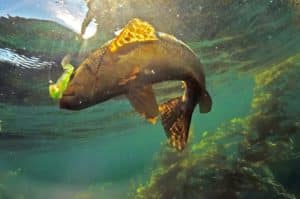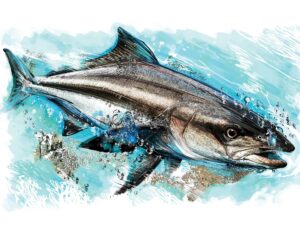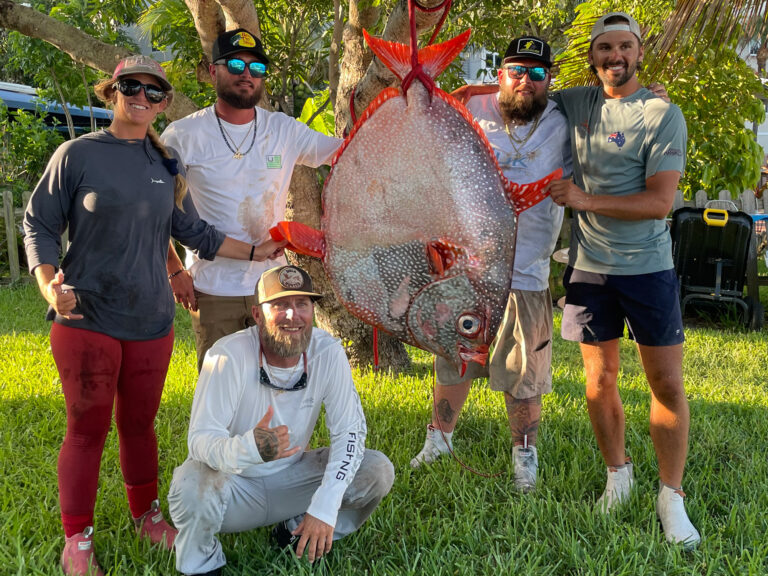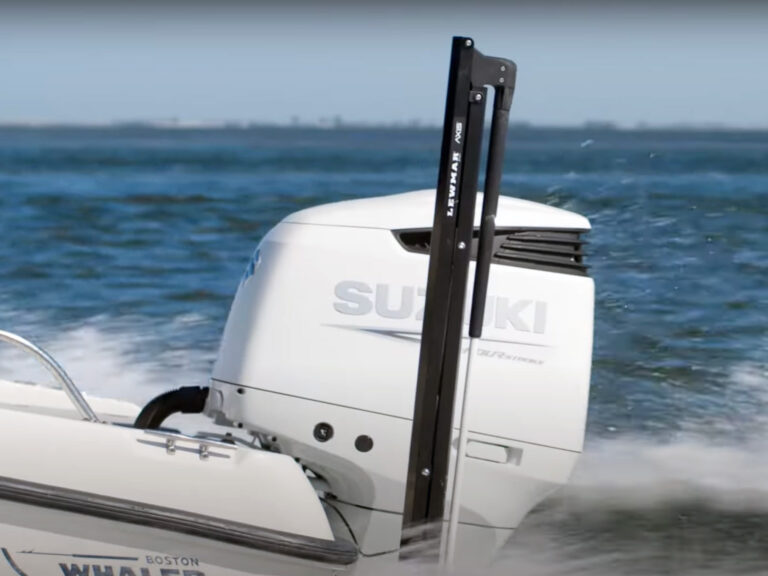
On my very first trip out an inlet to fish, I rode aboard an old, single-engine charter boat running from Morehead City, North Carolina. I quickly found the downside to trolling along a beachfront (whether within casting distance of the breakers or a few miles out): You fish beam to the seas pretty much all the time.
The net result? For me, at age 7, it meant depositing my breakfast into the nearshore Atlantic Ocean, followed by lunch, followed by anything else I tried to eat or drink, until my feet were once again planted firmly on land.
No matter. I managed to tough it out long enough to take several turns in the fighting chair, cranking hard on footlong Spanish mackerel — my first pelagic big-game conquests.
Looking back, despite my illness and the size of the catch, I learned an important lesson. Beaches are structure. When baitfish congregate close to the breakers, the beach offers them at least some protection from below and from one side. Bait gathering off the beach also enjoy cover provided by underwater points, bars, and contours that follow the beach’s geography.

The Grass is Always Greener
For bay anglers, the draw of trolling along a beach can be irresistible. Not only does it give small-boat anglers a shot at oceanic predators (when the weather is hospitable, of course), the major-league change of pace can be quite attractive — and effective.
“I love trolling the beaches because it offers variety,” says Capt. John Kumiski, who guides anglers to fish the Indian River Lagoon, the Banana River, and when conditions are right, the near-coastal Atlantic waters off Florida’s Space Coast. “King mackerel are mainly what we target, but we also get into big jacks, cobia, and sharks of all kinds.” Early summer provides the best shot at large kingfish close to the beach, while the cobia are thickest in spring.
Kumiski prefers slow-trolling live baits — particularly menhaden and mullet — because it generates strikes from all of these fish. “Some of the commercial guys use spoons, and they catch plenty of fish,” he notes. “But I find live baits to be the best pick.”

Favored live-bait rigs include an octopus-style 3/0 to 5/0 hook haywired to an octopus stinger. “Lots of guys like to use a treble for the stinger,” he says. “But I hate ’em. They’re not safe, and I don’t believe they work any better anyway.”
Kumiski spools 6000-series reels with 30-pound braid, but notes that anglers focused solely on kingfish often prefer monofilament since its stretch helps prevent hooks from tearing.
He recommends trolling as slowly as possible when targeting kings, even trimming up the motor to reduce forward thrust, if necessary. He also feels an electric trolling motor can be advantageous when prowling the coastline for kingfish.
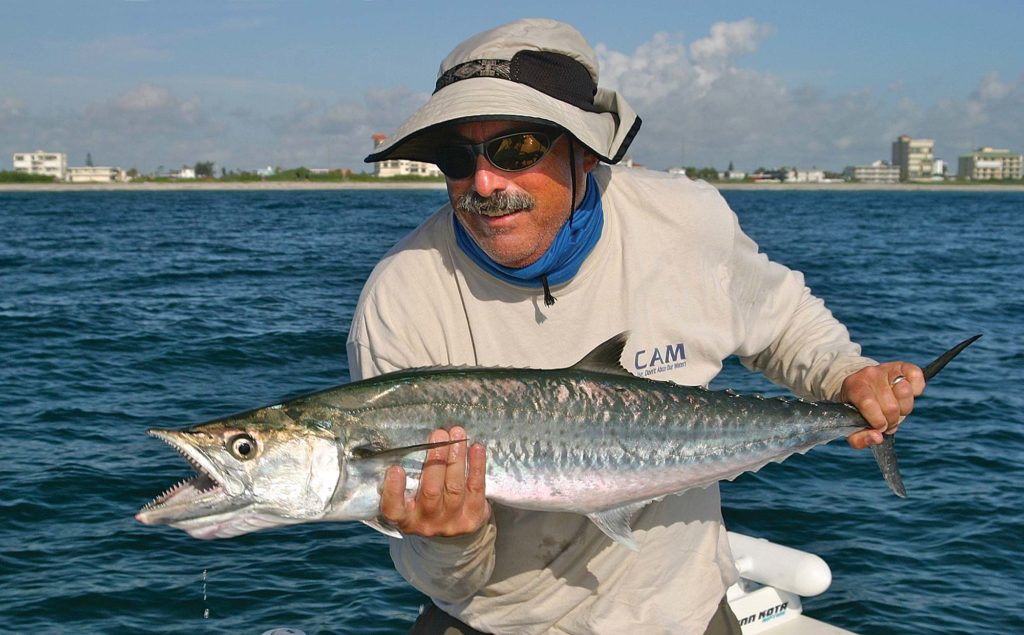
Beach Town
From the Space Coast to North Carolina, southern species remain the main target for many beachfront trollers. But once you move north of that dramatic, geographic protrusion known as the Outer Banks of North Carolina, the game changes significantly during late fall and winter.
“The fish we might troll for along the beaches include everything from Spanish mackerel and bluefish during the warmer months of the year to striped bass in late fall and winter,” says Capt. Nick Clemente of Get Sum Charters in Ocean City, Maryland. “Close in, during summer, along our beaches, most of the fish you catch are relatively small. Trolling small spoons is the best way to catch them, and it’s a fairly simple fishery.”
But when there’s a chill in the air and stripers begin moving down the coast, it triggers a radical change.
Read Next: Jetty Fishing Tips
“If stripers come down the coast close to the beach, fishing can be really good for very big fish,” Clemente explains. “But it all depends on how close to shore they stay. If they go outside 3 miles, they’re in federal waters, and you can’t legally fish for them. You want to locate shoals or lumps off the beach in 20 to 60 feet of water, within that distance, and you need to find bait around them. Find the bait, and then you’ll find the fish by trolling lures like Mojos, parachutes, and umbrella rigs.”
Clemente points out that those lures are the same ones guys use for stripers in the nearby Chesapeake Bay. However, trolling off the beach involves a lot more current. Depending on how deep the fish are holding, that means running lures below the 5- to 15-foot depths targeted in the bay. Anglers must add anywhere from 6 to 20 ounces of weight or choose heavy lures such as Mojos, which are readily available with heavy 16-, 24- or even 32-ounce heads.
Clemente says that most recently — in late December and early January — the entire season for this fishery lasted only about 14 days. Some years it doesn’t happen at all, if the fish migrate south while farther out to sea. But when the bite is on, it can mean constant action hooking into 40-plus-inch stripers through February.

California Dreaming
Although the beaches are quite different on the West Coast, according to Capt. Ben Florentino, who guides out of the Los Angeles area, trolling within a stone’s throw of the sand is still a great way to put fish such as yellowtail and white seabass in the boat.
“For us, the kelp can create quite a challenge,” he says. “You need to be right on the leading edge, which, because of the snags if you get into the kelp itself, is like trolling along the forbidden zone. Plus in some areas, like off Catalina, it can get crowded. But if you watch the meter and watch for birds, then find the zone where the drop-off, kelp and bait correlate — and if you can stay on that line — trolling off the beach can be very productive.”
Florentino says deep-diving lures and lipped crankbaits trolled at 4 to 5 knots can be effective. These lures dig down to specified depths, and can be selected for wherever the fish happen to be holding.
Otherwise, he likes slow-trolling live baits. “Sometimes depth isn’t so much of a player because of where the bait is found,” he explains. “When that happens, I like to troll live baits, and on a strike, drop back the other lines. Often that leads to multiple hookups.”
The bottom line on prowling any beach: The water’s point of contact with land creates a firm barrier where game fish and prey meet.

Beachfront Tactics
At first glance, it might seem like a beach reduces an angler’s options, but trolling along one is still a three-dimensional game, just like trolling in open water. To maximize the catch, many of the same lessons apply.
- Once you locate an effective depth, stick with it. Often this means shadowing contours in the shoreline.
- Points, outcroppings, sloughs and other interruptions in the beach are like structure within the structure. Consider any variation that continues out into deeper water as a potential fish magnet.
- Most seasoned beach trollers agree that slow-trolling live baits results in more strikes, regardless of target species. However, you have to know where and how deep the fish are holding.
Trolling lures fast often helps locate fish because you can cover a lot more ground. Once you’ve found the fish, you can switch to liveys.

